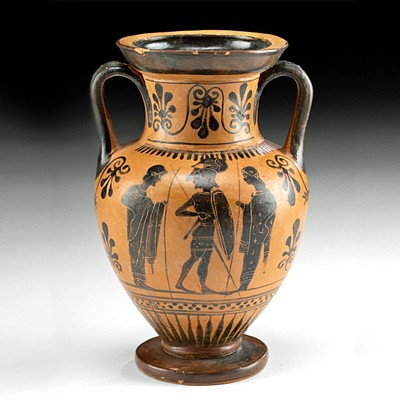Exhibited / Published Greek Coreform Glass Alabastron
About Seller
686 S Taylor Ave, Ste 106
Louisville, CO 80027
United States
Selling antiquities, ancient and ethnographic art online since 1993, Artemis Gallery specializes in Classical Antiquities (Egyptian, Greek, Roman, Near Eastern), Asian, Pre-Columbian, African / Tribal / Oceanographic art. Our extensive inventory includes pottery, stone, metal, wood, glass and textil...Read more
Two ways to bid:
- Leave a max absentee bid and the platform will bid on your behalf up to your maximum bid during the live auction.
- Bid live during the auction and your bids will be submitted real-time to the auctioneer.
Bid Increments
| Price | Bid Increment |
|---|---|
| $0 | $25 |
| $300 | $50 |
| $1,000 | $100 |
| $2,000 | $250 |
| $5,000 | $500 |
| $10,000 | $1,000 |
| $20,000 | $2,500 |
| $50,000 | $5,000 |
| $100,000 | $10,000 |
| $200,000 | $20,000 |
About Auction
Mar 9, 2023
Artemis Fine Arts info@artemisgallery.com
- Lot Description
Ancient Greece, Classical Period, ca. 5th century BCE. A stunning core-formed glass alabastron comprised of deep sea blue glass with opaque tangerine yellow and cyan blue trailing combed into a feathered pattern that envelops the entirety of the ovoid body. The discoid mouth flares outwards as a slender band of tangerine glass encircles the rim. Finally, a pair of applied trail handles, each in an elegant loop finishes the upper body. A divine work of glass art to be treasured for its impeccable form, beautiful hues, and sophisticated technique. Size: 1.5" W x 3.6" H (3.8 cm x 9.1 cm); 4.7" H (11.9 cm) on included custom stand. <br><br>The alabastron is a long-bodied vessel with a rounded bottom, a cylindrical neck, and a flat disk for a mouth. Though usually without handles, some alabastra have trailed handles like this example. According to the Beazley Archive of the University of Oxford, the alabastron shape's history extends back to Corinth, but was only preserved in Athenian pottery examples back to the mid-sixth century BCE. Alabastra were created in many materials, including alabaster, and the Greek term for this stone. Alabastron (most likely of Egyptian origin) - was the source of inspiration for the name of this shaped vessel. Many examples were finished with a white ground, as if to imitate this stone. Others, like this example, were created from colorful glass. We know from vase painting imagery of women using alabastra following a bath, that these vessels most likely held perfumed oils. <br><br>According to the Corning Museum of Glass, core forming is "the technique of forming a vessel by winding or gathering molten glass around a core supported by a rod. After forming, the object is removed from the rod and annealed. After annealing, the core is removed by scraping." This process of glass making was begun in the late 16th century BCE by glassmakers of Mesopotamia, and then adopted by Egyptian glassmakers in the 15th century BCE. The technique almost came to an end in the so-called Dark Ages of Mediterranean civilization (1200 to 900 BCE); however, by the 9th century BCE a new generation of glassmakers took up the technique once again, and between the 6th and 4th century BCE core-forming spread throughout the Mediterranean. <br><br>Exhibited in "Ancient Glass: Selections from the Richard Brockway Collection" at the Hallie Ford Museum of Art at Willamette University, Salem from March 10 to May 19, 2007 and "Glass of the Ancient World" at the Vero Beach Museum of Art, Florida from October 11 to December 28, 2008. <br><br>Published in "Ancient Glass: Selections from the Richard Brockway Collection." Hallie Ford Museum of Art at Willamette University, Salem, 2007; "Glass of the Ancient World." Vero Beach Museum of Art, Florida; and "Antiques & Art Around Florida," Fall 2009 - Winter 2010. "Collecting Ancient Glass" by Richard Brockway with Lynette Macleod, pp. 27.<br><br>Provenance: private Vero Beach, Florida, USA collection, acquired before 2003 <br><br>#177398
Condition
Small area of some pitting on body below rim, and light surface wear as shown. Otherwise, intact and in overall excellent condition with impressive preservation of form and pigments.
- Shipping Info
-
All shipping is handled in-house for your convenience. Your invoice from Artemis Gallery will include shipping calculation instructions. If in doubt, please inquire BEFORE bidding for estimated shipping costs for individual items.
-
- Buyer's Premium



 EUR
EUR CAD
CAD AUD
AUD GBP
GBP MXN
MXN HKD
HKD CNY
CNY MYR
MYR SEK
SEK SGD
SGD CHF
CHF THB
THB














